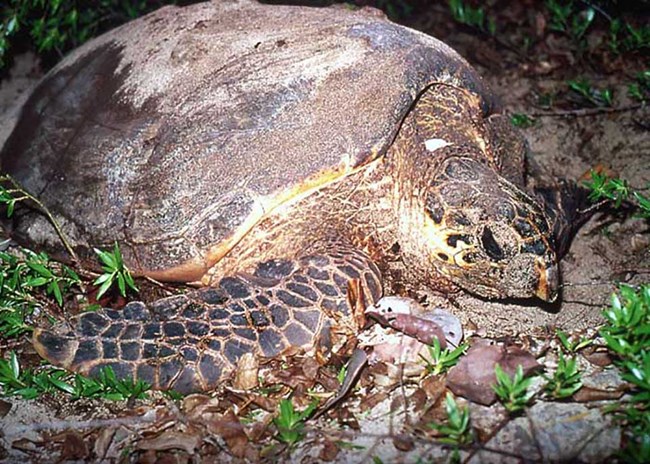The following is a blog entry from one of our ProRangers, Connor Caruso, who spent this summer interning at Christiansted National Historic Site (CHRI). You can find more adventures from Connor and the other ProRangers over at the intern blog.
Although my time at Christiansted National Historic Site has come to an end, I wrapped up the summer with the resource management division and the turtle team. I spent the last few nights at Buck Island Reef National Monument working with the resource management division to conduct the annual turtle monitoring program. Each year, the resource management division monitors the nesting hawksbill and green sea turtles who come to Buck Island. The research helps determine the health of the endangered species and provides data into the number of nesting spots on the beach.
 Nesting sea turtles emerge from the sea after the sun has set, which means that research occurs throughout the night! Each hour, two teams depart to walk the beach and check to see if any turtles have emerged. Lines are drawn in the sand to help indicate whether any turtles have crossed. If a turtle emerges from the sea, tracks are left in the sand.
Nesting sea turtles emerge from the sea after the sun has set, which means that research occurs throughout the night! Each hour, two teams depart to walk the beach and check to see if any turtles have emerged. Lines are drawn in the sand to help indicate whether any turtles have crossed. If a turtle emerges from the sea, tracks are left in the sand.
Once on the beach, the nesting turtles search for an ideal location to make a nest. While the green sea turtles prefer wide-open areas on the beach, hawksbill sea turtles prefer the more forested areas near the tree line. Sometimes, the turtles emerge from the sea to look for a nest and decide against nesting. This can be caused by any number of factors, including: obstacles that get in their way, sand conditions that aren't favorable, and unfamiliarity with the nesting process. However, once a turtle decides to nest, the resource management team springs into action. The process of building a nest and laying eggs last approximately 30-45 minutes and places the turtles into a trance which allows the resource management team to take measurements, pictures, and secure identification tags to the turtle's flippers.

After the research is conducted and the turtle has laid her eggs in the egg chamber, the resource management team maps the nesting site to protect the site against human encroachment. Sixty days after the eggs are laid, hatchlings emerge from the nest and dash towards the sea. While in season, a mature female turtle can return to the beach every 12-14 days to lay. Each time a nest is made, roughly 150 eggs are deposited. Although the survival rate of the hatchlings is low, the work conducted by the turtle team ensures each hatchling has the best chance of survival.
Working with the turtle team was a lot of fun and gave me a newfound respect for the hardworking people in the resource management division. Protecting the resources entrusted to the National Park Service is a vital part of the mission, and I'm glad I was able to help out!

Sunrise at Buck Island

